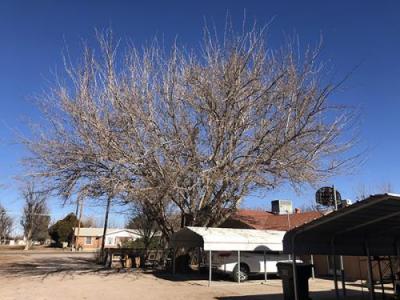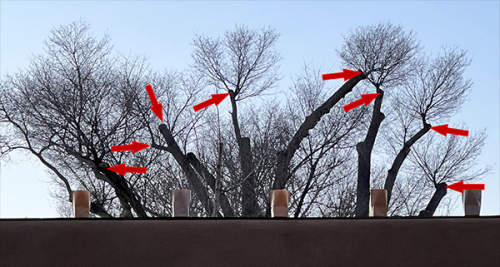February 19, 2022
Big Decisions About Pruning Even Bigger Trees
Question:
I have a very large mulberry tree that offers great shade on the west side of my house in the summer. Last spring, I hired someone to cut back the limbs over the house and carport where they were dragging on the roof and the electrical line. There is an area of branches that are thick and will be hanging over the driveway by mid-summer this year. I have talked to a tree trimmer who is willing to do a minor trimming, but said that eventually I will need to cut the tree back significantly, down by about half. He said it will be healthy, leaf out, etc., and be better for the tree. He also said he would not cut it back once it begins to bud out. Does a mulberry tree this size need to be cut back by half now or in the future for its health or safety? I am thinking I may just not prune this year until I know more and am sure of what the tree needs.
- S. White, Doña Ana County
Answer:
I’m so glad you’re asking this question. I too had a huge non-fruiting mulberry in my yard when I lived in Las Cruces, and I remember wondering the same thing. At the time, we opted to trim the few branches that were touching the roof (and low enough to reach without a ladder). While our decision was largely based on having a limited budget, it turned out to be the right decision for the tree—and our precious shade.

I’m inclined to suggest waiting until the tree leafs out this spring to focus on whether or not there is any branch dieback, and then decide if the deadwood should be pruned out. Smaller dead branches within the canopy may not become a problem. If larger limbs are dead, hiring a professional tree pruner to remove them safely will be the best option. While all pruning cuts injure trees, the larger the diameter of a cut limb, the more energy is required to seal the wound.
Cutting the tree back by half sounds like a procedure known as “topping.” In addition to being detrimental to tree health, this practice has been proven to increase the chances of future limb breakage. As noted in the 2001 International Society of Arboriculture (ISA) Arborists’ Certification Study Guide, severe topping “causes branch dieback, decay, and sprout production from the cut ends, resulting in a potentially hazardous situation once the sprouts become large and heavy. Topping or heading back is not a recommended pruning practice.”
In the late, great Dr. Alex L. Shigo’s super-helpful book, Tree Pruning: A Worldwide Photo Guide, topping is listed as one of seven major (and unfortunately common) pruning problems. “4. Topping and Tipping Large Trees. The practice causes serious injuries to large trees and leads to hazardous conditions. Do not plant trees under power lines. Or, plant only small-maturing species. Or, start pruning when the trees are small.” Check out this week’s blog post for the other six pruning no-no’s and a link to Dr. Ed Gilman’s short and snappy article, “Do Not Top Trees” at Desert Blooms.
But hold on a minute. If we know topping is so bad for trees, why is it still common practice? Well, there are several factors. For one, changing normalized behavior is difficult. When we see topped trees in our communities we tend to think that must be the way it should be. Also, large tree pruning is HARD. This line of work requires skill and is physically difficult—at times dangerous, and that’s why pruning services can be expensive. Selective, careful pruning also takes more time. Furthermore, many of our urban trees were topped decades ago, and corrective pruning (aka crown restoration), while possible, usually requires multiple years of successive prunings.

Some tree species are more sensitive to topping than others. And an important distinction should also be made between proper care for ornamental landscape trees versus commercial tree crops. As management goals vary, so do management practices. For example, recommendations for pecan production in New Mexico include mechanical hedging of mature trees on a multi-year cycle to allow sunlight into the inner canopy to maximize yield potential (both quantity and quality). Selective, careful thinning to open the canopy of hundreds of pecan trees quickly becomes cost-prohibitive.
Speaking of orchard management, NMSU Extension Fruit Specialist Dr. Shengrui Yao is hosting a virtual Fruit Grower Workshop on Wed. March 2, 2022 from 9 am to 2 pm. This is a free online event, but registration is required. Topics include orchard maintenance, irrigation, planting, and growing grapes! Visit Rio Arriba for more information.
For their added insights on this mulberry query, I shared the details with my predecessor and mentor Dr. Curtis Smith, and the person who inspired me to go back to school to study horticulture and pursue a career in the Cooperative Extension Service, Joran Viers. In addition to helping me with complex questions, in retirement, Dr. Smith continues to teach horticulture classes in New Mexico and Texas, and Viers is now a horticultural consultant and ISA Board Certified Master Arborist.
Smith and I spoke on the phone while carefully reviewing each of the submitted photos. It can be difficult to identify deadwood in the winter when all the leaves are gone—and even more so from a winter photo. We detected only a few smaller limbs that might be dead in the interior canopy. Overall, we agreed that the tree looks good may not need major pruning. Smith did note that some careful thinning could be beneficial, and the limbs over powerlines should be watched each year and may need attention if dieback becomes an issue.
Viers replied via email and remarked, “I took a look at the photos. I doubt there is a lot of deadwood, and I don't see any need to whack it back by half, for sure! There are a lot of small-diameter branches, and even the big branches are smallish because there are so many branches in there. Some thinning might be in order, but I balance that thought with thinking about how all those intergrown branches help hold each other up and in place. Definitely wait until mid-May or later to assess and then 1) prune deadwood larger than a 2-inch diameter, 2) prune limbs causing clearance issues (house, utility lines, etc.), and 3) do some light thinning in the outer half of the canopy. If possible, don’t cut limbs larger than 3 inches in diameter.” He added, “If the canopy size is adequate, leaving some of the dense growth inside (less thinning) will distribute annual growth across more points, and consequently each will grow less. It will also leave the tree with fewer wounds to have to contend with, so less disease and decay potential.” As far as deciding whether to prune this year or wait until next year, “The amount of deadwood might be the determining factor, and even that is mostly from an aesthetic point. Mulberry trees hold deadwood very strongly, and when it does finally break off, it more often than not gets stuck on the way down, never making it to ground.”
Marisa Y. Thompson, PhD, is the Extension Horticulture Specialist, in the Department of Extension Plant Sciences at the New Mexico State University Los Lunas Agricultural Science Center, email: desertblooms@nmsu.edu, office: 505-865-7340, ext. 113.
Links:
For more gardening information, visit the NMSU Extension Horticulture page at Desert Blooms and the NMSU Horticulture Publications page.
Send gardening questions to Southwest Yard and Garden - Attn: Dr. Marisa Thompson at desertblooms@nmsu.edu, or at the Desert Blooms Facebook page.
Please copy your County Extension Agent and indicate your county of residence when you submit your question!